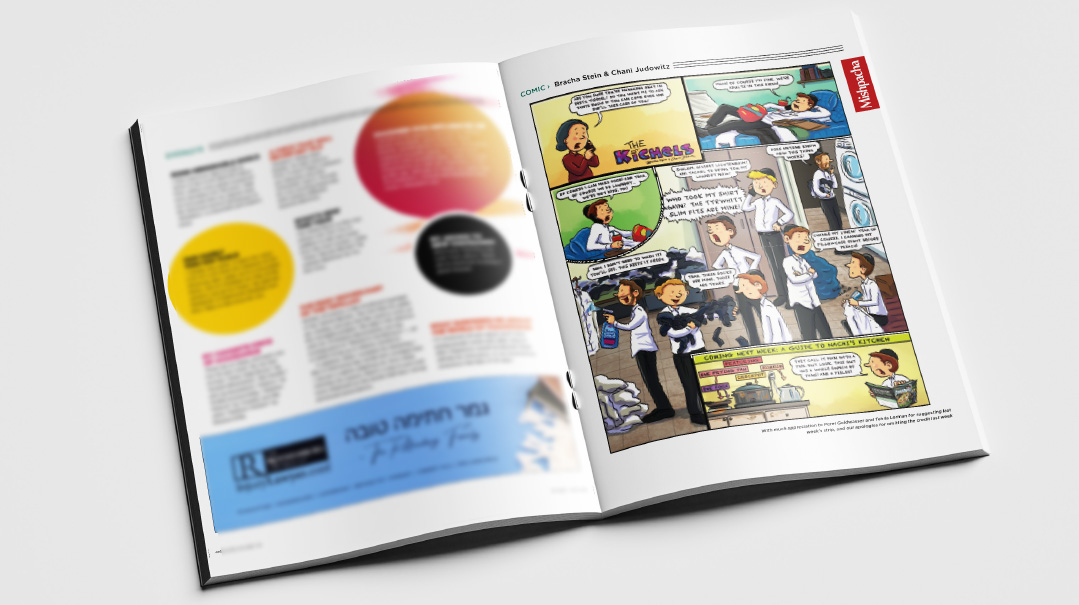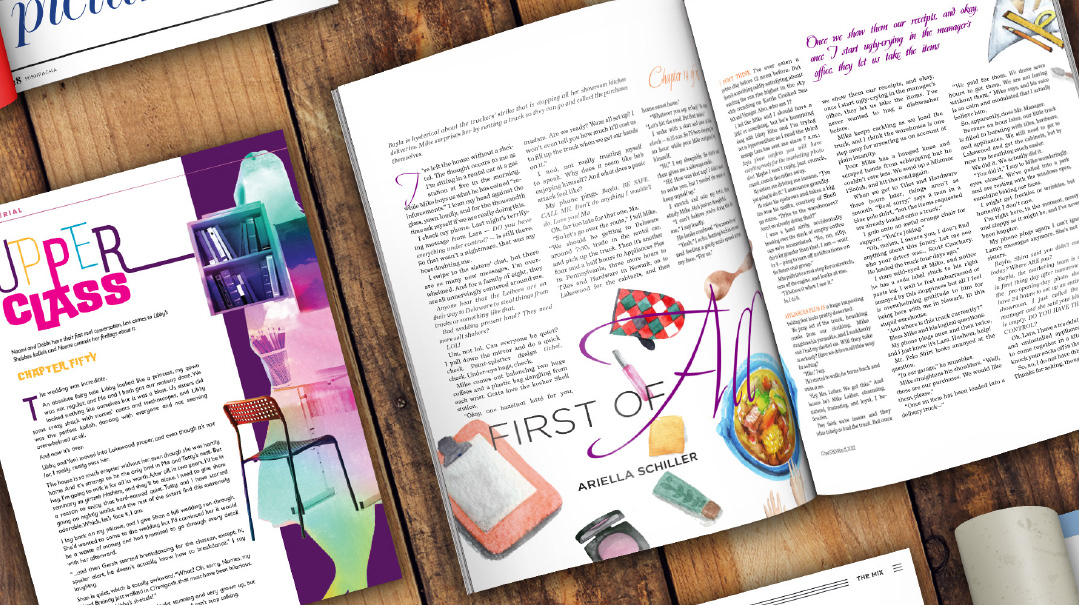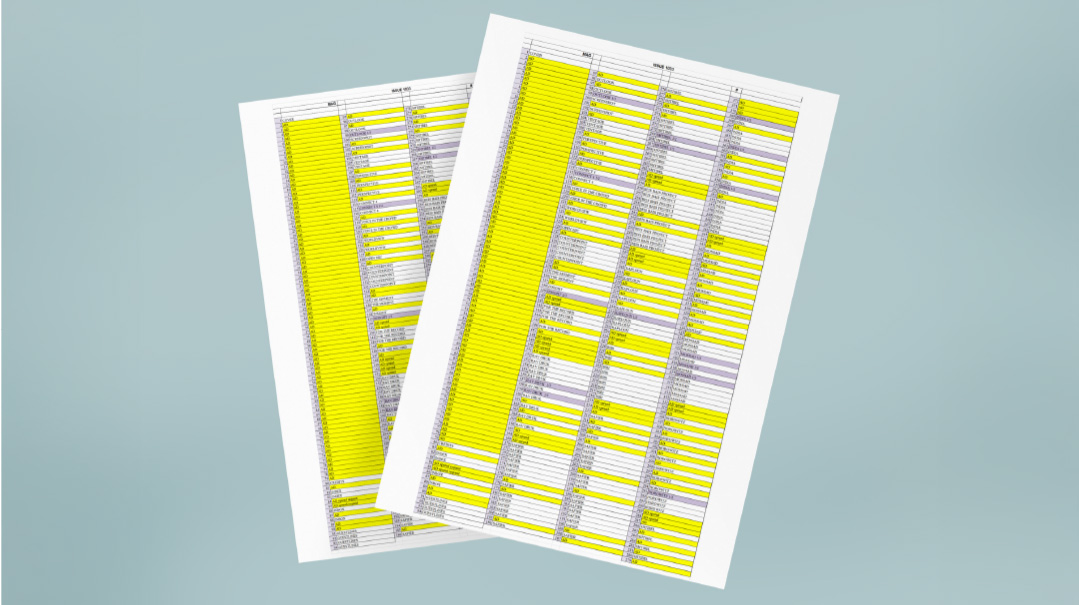20 Questions for Bracha Stein & Chani Judowitz
| October 13, 2024“It’s such a great feeling to hear about its impact, or to hear readers casually reference having a ‘Kichels moment’ or saying ‘we are the Kichels’”

Bracha Stein is the pen name of a humor writer and Mishpacha staffer who lives in Jerusalem.
Chani Judowitz is an illustrator and fine artist who lives in Lakewood, New Jersey. Their collaboration on the weekly Kichels comic is the stuff bestsellers — and must-read back pages — are made of.
My ideal work environment
Bracha: A remote mountain cabin abutting a lake in which I will produce works of genius with calm and serenity. In real life, though, my creative process involves lots of nervous pacing and procasti-working as I wander my home in search of inspiration and/or distraction, so perhaps that might not pan out exactly as I’m envisioning it.
Chani: Currently my ideal work environment is my new art studio, with a hot coffee and/or some Diet Snapple Half ‘n Half.
Deadlines make me
Bracha: Produce. No deadline, no Kichels.
Chani: I have mixed emotions about deadlines. They make me very productive, but I really can’t handle last-minute pressure. Generally, I try to be organized about deadlines and submit early. With a weekly deadline like the Kichels, this is sometimes impossible. So let’s just say that I’m becoming more flexible as time goes by.
I’ve learned the most from writing about
Bracha: Reading. Hands-down, the best way to learn, improve your craft, and procrastinate (when you’re not pacing).
The accomplishment I’m proudest of
The Kichels has been such an incredible (and unexpected!) source of nachas. It’s such a great feeling to hear about its impact, or to hear readers casually reference having a “Kichels moment” or saying “we are the Kichels.”
The best piece of advice I got
Chani: Always put your best work into a project. Never do half a job because the pay isn’t great or because a project is less exciting. This advice has helped my career tremendously.
1. How many years have you been at Mishpacha, and what did you do before that?
Chani: I’ve been working in freelance illustration for 12 years. The Kichels are celebrating their seventh anniversary — wow! — so that’s how long I’ve been working for Mishpacha (although I’d done some small jobs for the magazine before that).
Bracha: Before joining Mishpacha’s staff full-time in 2017, I worked as a writer in various fields — mostly academic, all boring. I was desperate for a fun, creative outlet, and when managing editor Shana Friedman suggested that I write a comic strip (in response to some emails begging Mishpacha let me do something fun professionally suggesting a humor column would be an asset to the magazine package), I jumped at the chance with all the desperation a bored textbook editor can muster (that is to say, a lot). I ended up joining Mishpacha’s staff (where I do un-Kichel-related work also, although no one seems to care about that) at around the same time.
2. How long did you know each other before you created the Kichels?
After securing our mutual tentative interest in a strip, Shana arranged a meeting together with us in the office. We’d never met before, but she thought we’d make a good team. And — as with most things — Shana was right.
3. Who came up with the Kichels’ name, and what was the reason for it?
In our brainstorming sessions, we realized that we wanted a memorable name, one that readers could easily reference — “Oh, did you see this week’s __________?” We realized that meant we needed something quick and simple. Chani researched a number of other comic strips and noticed that a lot were named after foods (think Peanuts and Pickles). She suggested a few Jewish foods that could work: Tradition Soup, farfel, lokshen…
Looking at the list, one stood out. It was memorable, Jewish-sounding, and didn’t have a whole lot of previous associations with it. (Somehow, choluptches and galla didn’t have the vibe we were going for). And so, the Kichels were born.
4. Why did you include redheads in the family?
In our first two strips (Issues 680 and 681), Nechama appeared only in a snood. Then we came to the third strip (Issue 682), in which several identically dressed mothers attend PTA and sit side by side. Chani realized that from a visual standpoint, it was important that Nechama stand out from the other women, so she gave her a red sheitel. And then we varied the hair color of the kids to make it apparent who’s who.
5. How long does it take to create the average strip? What’s the process like?
It’s a creative, collaborative, and, uh, convoluted process. It starts with Bracha frantically scrounging for ideas (her inbox, her brain, her sisters) and then coming up with a few to run by Shana. Every idea needs to have a universal element underlying it, and then a punchline (if it’s a strip told in panels) or a strong frame (if it’s a single-panel strip). It’s a tall order.
Hopefully, Shana greenlights at least one of the ideas (if not, it’s back to scrounging), at which point Bracha needs to research the strip, trying to nail down details like what brand clothing Chaviva wants to buy, what bein hazmanim trips Nachi might go on, or what ingredients Chaykie might be trying to source for a recipe. Then Bracha needs to write and plan out the strip (she writes it scene by scene, panel by panel, although Chani might tweak those to work visually). The dialogue — especially the punchline! — often takes a couple rounds to perfect. Then the Word document goes on to Chani, who lays the text out in a Photoshop file, to make sure it all fits and that the composition works. She creates a rough sketch. It’s always easier to make changes earlier in the process, so Bracha and Shana review it to see if they have any concerns or suggestions. If it’s approved, Chani moves forward with the linework. Sometimes there will be changes or corrections at this stage, where it’s easier to see details (for example, Bracha may request a change in a character’s expression). When Bracha’s not sure about the dialogue or realism of some details — somehow, this becomes more evident as the strip takes form — she’ll often forward the script to some beta readers to get their opinions. Finally, Chani moves on to the coloring (her favorite part).
This whole process usually takes us from Monday through Thursday, and that’s hoping there are no last-minute tweaks, edits to the punchline, or editorial requests that we rush in by closing day — not that we would ever make a change after submitting a strip, we’d never be that annoying. (But, uh, someone should give Chava Lipszyc of production a standing ovation.)
6. What happens if Chani hates a script that Bracha spent hours creating?
This happens rarely — but it does happen. However, a huge part of the comic’s success (in our humble opinion) is the mutual respect we each have for each other’s opinions. That’s true on a practical level (it’d be hard to work so closely with someone on a weekly column, books, and games without that mutual respect) as well as a deeper one — the collaboration, synergy, and back-and-forthing we do lead to a much richer, more dynamic end product.
Now back to the question. We try to do whatever we can to avoid this: If Bracha’s working on a tricky or complex strip, she’ll talk it out with Chani first to see if she hates the idea (which Chani tries not to do).
Sometimes, though, it’s unavoidable. Maybe Chani has a strong reason why a strip won’t work that didn’t occur to Bracha, so she didn’t proactively ask about it in advance, or maybe Chani liked the idea when she heard about it over the phone, but when she saw the script, she realized that she wasn’t sure how it would work visually. (As a non-artist, Bracha has been known to sometimes give impossible instructions: “So in this next panel, please show Yechiel standing still, but also walking across the room, and show him head-on while also giving us a bird’s-eye view.”) That’s where the mutual respect comes in — if Bracha feels strongly about a script, she’ll push back or give suggestions (sometimes accompanied by breathtaking sketches dashed off with all the panache of a two-year-old), but if Chani still feels firm about her concerns, we’ll scrap it.
This goes both ways — sometimes Bracha will have a drawing suggestion or edit, which Chani always considers seriously, even when it’s coming at an end stage from a decided non-artist. (See above.)
Really, it’s about both sides listening to each other. One example was “The (Former) New Yorker (Issue 919 ).” Bracha loved the idea and sent over the script, not realizing how hard it would be to execute since it was modeled after a famous New Yorker strip. But when Chani saw the script, she felt totally stuck when it came to figuring out how to draw it. We ended up putting it on hold for a few weeks until Chani figured out the best way to fit it all in — and when she did, it became one of our most popular strips ever. Of course, in retrospect, it looks so obvious (the mark of real artistry!).
7. Do you have personal favorites among the characters?
Shhh, don’t tell them, but, well… Nachi and Chaviva have the most personality. And Yechiel and Nechama are our strip’s backbones — so relatable.
8. Where do the Kichels actually live?
We tried to keep it vaguely Tristate, but we let it slip in a comic or two that they live in Flatbush.
9. Did Ben Shapiro see the strips featuring him?
Yes, a Mishpacha staffer emailed it to him, and he very kindly wrote back, “LOL!,” a statement that makes it patently obvious that he knows the Kichels, read that strip, found it hilarious, and was blown away by our sharp perspicacity and humor. We can consider this a definite endorsement.
10. What do you consider the most epic Kichels strip ever?
Whoa, this interview is brutal! First a favorite character, then a favorite strip? Hard to choose, but “Is it Shabbos Yet?” (Issue 784) still makes us laugh — and was definitely a reader favorite.
11. Is there a topic you won’t touch, on principle? Why?
We believe humor is a great tool for empowering you to take back control of any circumstance, even the toughest ones. That’s why dark humor is so popular. That said, we try to steer clear of truly painful problems; it’s one thing to poke fun at your own situation, it’s another to have that cute comic family that lives in the back of the magazine doing so. We don’t talk about issues like divorce, children at risk, death, etc.
When we do tackle tough issues, we often try to find a less painful framing. For example, when we discussed school acceptances, we did it with four-year-old Pinny, not an ascending high schooler with nowhere to go; when we talk about shidduchim, it’s with 22-year-old Rochi, not a 38-year-old woman.
Most of our strips are more gentle, but we have included some heavy-handed criticism of issues within the community. When we do so, we’re mocking societal constructs, not features of frumkeit. We will never, ever poke fun at Torah or halachah, chas v’shalom, or disparage a mitzvah. So, while we might run a strip mocking the frum convention of dressing little kids in certain styles and the shopping stresses that accompany that, or the cooking hysteria we work ourselves into, we’d never do a strip that might imply that Yom Tov is a burden. We think of the Kichels as a celebration of frum life and community — and we think that that love and pride come through in the end result.
12. What’s the most controversial Kichels you’ve ever run? Did you expect it to be that divisive?
Ouch. Another brutal question. Honestly, it’s almost disappointing how non-controversial we are. We waited on tenterhooks for angry letters in response to some of our more pointed social commentary type strips — like the Silka sheitel ad noting the “rights” married women receive (Issue 832), or the strip about the promises of yeshuos made by tzedakah organizations (Issue 895) — but we received far more agreement than dissent. (Surprisingly, our strip about men grocery shopping received far more complaints from insulted male shoppers. Make of that what you will.)
13. Did you ever expect the comic to become such a cultural icon?
Definitely not! Honestly, we were both pretty skeptical about the idea — a comic strip serial? For adults?! — as was pretty much everyone who heard about it. It took our visionary editor to see the potential in this idea and really push everyone to make it happen. We agreed to do it as a three-month experiment — and, seven years later, baruch Hashem, we’re still going strong.
14. Do your kids go around saying “my mother writes the Kichels,” or do they hide whenever their friends bring it up?
Chani: I don’t think they go around announcing it, but their friends like to tell others around them. They are very proud to be a part of the Kichel family — and every now and then they give me ideas or pressure me to let Rochi get engaged already.
15. Where do you get inspiration?
Bracha: Everywhere. Anywhere. Nowhere. There are so many Kichel moments all around — I try to make note of them so that I can use them. Of course, I usually make mental notes of them, which promptly fade, leaving me scrounging on deadline day.
16. Tell us about columns that got pulled
It’s vital to us that our columns stay on the right side of the line and are not seen as disparaging our community or its hashkafos. If we’re working on one that may seem controversial, we’ll run it by Mishpacha’s rabbinical board before we even sketch it out.
True story: Our spoof of “The Very Hungry Caterpillar” was almost pulled at the eleventh hour, when the rav reviewing it thought it might be seen as mocking (hungry) yeshivah bochurim. We had to kick our bochur out of his sleeping cocoon a bit earlier to make it clear that we weren’t implying that yeshivah bochurim sleep all day.
17. How many letters did you REALLY get when the Kichels took an extended break?
Literally millions. Mishpacha had to open a dedicated mailbox for devastated Kichel fans. (We don’t work in the office, and Bracha was on leave, so we don’t know for sure, but this seems like a safe assumption.)
18. What’s the subject you’ve covered most?
We try to switch up topics, but let’s be real, we’ve definitely done the most about shidduchim as well as strips featuring the differences between men and women. They may be stereotypes… but don’t stereotypes usually exist for a reason? (Please don’t write us more angry letters, Insulted Male Grocery Shoppers.)
19. Are you actually planning to marry Rochi off?
We would like to… one day! But a number of women in shidduchim and their parents have told us how validating they find shidduch strips, and how they want Rochi to stay in shidduchim as long as they are.
20. Do any readers not like the Kichels/skip them? Which demographic?
Chani: I’ve definitely met people who get Mishpacha weekly but have no idea what the Kichels are. And they claim they do read the magazine. I’m not sure what to make of that….
Bracha: I live in Israel and write under a pen name, so I don’t get that same face-to-face feedback. I was once sitting on a bus when the woman in front of me pulled out a Mishpacha. I leaned forward a bit, intrigued. Real-live feedback in the wild! The woman turned right to the back of the magazine, and I sat up a bit straighter, trying to keep the smug grin off my face. Then she proceeded to fold the magazine, turn it Kichel-side-down, and closely read… every single word in the Communicated content alongside it. (Advertisers, pay attention.) She never read the Kichels at all.
(Originally featured in Mishpacha, Issue 1033)
Oops! We could not locate your form.







